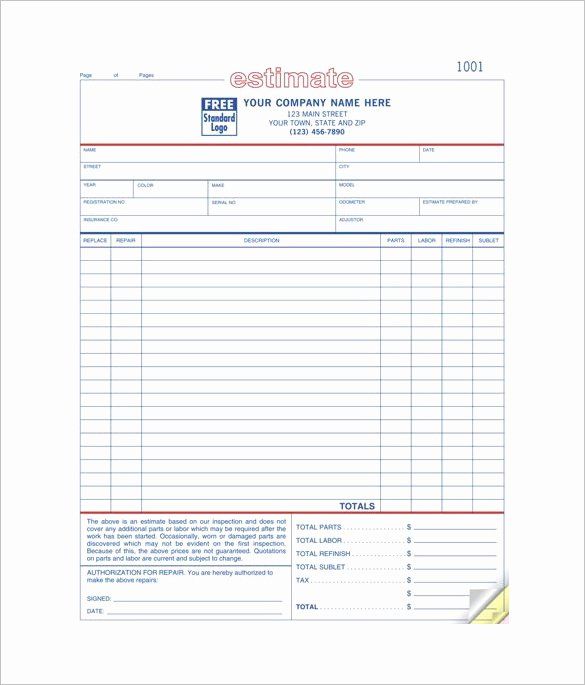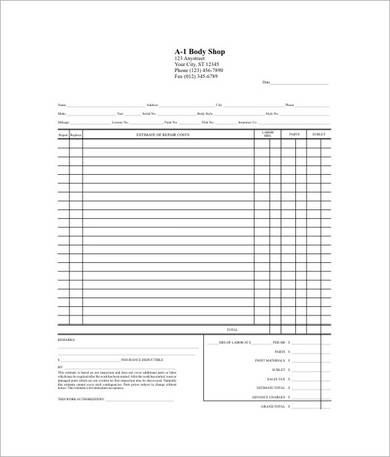
How to Read an Auto Repair Estimate
If your car is in need of repair, it’s important to understand the estimate provided by the mechanic or auto repair shop. A repair estimate outlines the cost and details of the work that needs to be done on your vehicle. However, deciphering these estimates can be confusing if you don’t know what to look for.
Learning how to read an auto repair estimate is crucial for any vehicle owner. This comprehensive guide will walk you through the process, explaining the key components and terminology you need to know. With this knowledge, you’ll be able to make informed decisions about the repairs your car needs.
An auto repair estimate typically includes several sections, such as labor costs, parts costs, and miscellaneous charges. Understanding each section is essential in order to determine the overall cost of the repair. Additionally, being able to identify any unnecessary or excessive charges can save you money.
Throughout this guide, we will highlight important information to pay attention to, as well as provide tips and insights from industry experts. By the end, you’ll be equipped with the knowledge and confidence to read an auto repair estimate with ease. Don’t let a repair estimate intimidate you – take control of your car’s maintenance and repairs.
Understanding Auto Repair Estimates
When your car needs repairs, it’s important to have an accurate estimate of the costs involved. An auto repair estimate provides a breakdown of the expected costs for parts and labor. Understanding how to read and interpret an auto repair estimate can help you make informed decisions about the repairs needed for your vehicle.
An estimate is a detailed document that lists the various components of the repair job. It typically includes a list of parts needed, the cost of those parts, and an estimate of the hours of labor required. The estimate may also include additional fees or charges, such as diagnostics or disposal fees.
Reading an auto repair estimate starts with reviewing the list of parts. Each part should be clearly listed, along with its individual cost. It’s important to compare these costs to ensure they are fair and reasonable. If you have any doubts, you can do some research or ask for a second opinion.
The next section of the estimate will detail the estimated hours of labor required for the repair job. This is typically broken down into different categories, such as diagnostic time, removal time, and installation time. The hourly rate for labor should also be clearly stated. Be sure to review these estimates carefully and ask for clarification if anything is unclear.
In addition to the parts and labor costs, an auto repair estimate may include additional fees or charges. These can vary depending on the repair shop and the specific job being done. Common additional charges include diagnostics fees, disposal fees, shop supplies, and taxes. Make sure to review these charges and ask about any that are unclear.
Understanding how to read an auto repair estimate can help you make informed decisions about your vehicle repairs. By comparing the listed parts and labor costs, as well as any additional fees, you can ensure that you are being charged fairly for the work needed. If you have any questions or concerns about the estimate, don’t hesitate to ask the repair shop for clarification. A reputable shop will be happy to explain the details of the estimate and address any concerns you may have.
What Is an Auto Repair Estimate?
An auto repair estimate is a document that provides an itemized breakdown of the costs associated with repairing a vehicle. It is essential for anyone looking to have their vehicle repaired to have a clear understanding of how to read an auto repair estimate.
The estimate will typically include information such as the parts and labor costs, as well as any additional fees or taxes. It is important to carefully review the estimate to ensure that all necessary repairs are included and that there are no hidden charges.
When reading an auto repair estimate, it is helpful to have a basic understanding of the terminology used in the industry. For example, knowing the difference between parts and labor costs can help you accurately assess the overall expense of the repairs.
Additionally, it is important to pay attention to any warranty or guarantee information provided on the estimate. This will help you determine the level of confidence the repair shop has in their work and the parts they are using.
In summary, an auto repair estimate is a crucial document that allows vehicle owners to understand the costs associated with repairing their vehicle. By learning how to read an auto repair estimate, you can ensure that you are receiving a fair and accurate assessment of the repairs needed.
Why is it Important to Read an Auto Repair Estimate?
Knowing how to read an auto repair estimate is crucial when dealing with automotive repairs. When your vehicle requires repairs, it’s important to understand the estimate provided by the repair shop. An auto repair estimate is a document that outlines the estimated cost of labor and parts needed to fix the vehicle.
By reading an auto repair estimate, you can gain a better understanding of what repairs are needed and how much they will cost. This information allows you to make informed decisions about which repairs to approve and which to decline.
An accurate estimate helps you avoid unexpected costs and ensures that you’re not overcharged for repairs. It allows you to budget for the repair and plan accordingly. Additionally, being able to read and understand an estimate puts you in a better position to negotiate with the repair shop if necessary.
Moreover, reading the estimate gives you the opportunity to verify that the repair shop has correctly identified and diagnosed the issues with your vehicle. It allows you to question any ambiguous or unclear items on the estimate and seek clarification from the repair shop.
Overall, being able to read an auto repair estimate empowers you as a vehicle owner. It helps you make informed decisions, avoid unnecessary costs, and ensures that you receive the necessary repairs at a fair price.
Components of an Auto Repair Estimate
When it comes to getting an auto repair estimate, it’s important to understand the different components that make up the total cost. By knowing what to look for, you can better understand how to read and evaluate the estimate.
1. Labor Costs: The first component of an auto repair estimate is the labor costs. This includes the amount of time that will be spent by the mechanic to perform the necessary repairs. Labor costs can vary depending on the complexity of the repair and the hourly rate of the mechanic.
2. Parts Costs: Another important component is the cost of the parts that will be used in the repair. This can include anything from a simple belt or hose to a more expensive engine component. The parts costs can depend on the quality of the parts and whether they are brand new or used.
3. Additional Costs: In addition to labor and parts, there may be additional costs included in the estimate. This can include fees for diagnostic tests, disposal fees for old parts, or any other miscellaneous charges.
4. Taxes and Fees: It’s important to consider any applicable taxes and fees that may be included in the estimate. This can include sales tax on parts or any fees associated with the repair shop.
5. Total Estimate: Finally, the auto repair estimate will provide you with the total cost of the repairs. This is the sum of all the components mentioned above and will give you an idea of how much you can expect to pay for the repair.
By understanding these components, you’ll be able to read an auto repair estimate with confidence and make an informed decision about the needed repairs. Remember to always ask for a detailed estimate and don’t hesitate to ask any questions if something is unclear.
Vehicle Information
When you need to read an auto repair estimate, the first step is to locate the section that contains the vehicle information. This section provides important details about the vehicle that the estimate is for.
The vehicle information typically includes:
- Make and model: The make refers to the manufacturer of the vehicle, while the model specifies the specific type or version of the vehicle.
- Year: The year indicates the manufacturing year of the vehicle.
- VIN (Vehicle Identification Number): This unique 17-character code is used to identify individual vehicles and can provide additional details about the vehicle’s specifications.
- Mileage: The mileage indicates the total distance the vehicle has traveled.
Having accurate vehicle information is crucial for understanding the repair estimate, as the cost of parts and labor may vary depending on the specific make, model, and year of the vehicle. Additionally, knowing the mileage can help the estimate provider determine the wear and tear on the vehicle.
Make sure to carefully review this section of the estimate and ensure that the vehicle information matches your vehicle to avoid any misunderstandings or discrepancies.
Cost Breakdown
When receiving an auto repair estimate, it is important to understand the cost breakdown. This breakdown will provide a detailed explanation of the expenses you can expect for the repair. By knowing how the estimate is broken down, you can make informed decisions about the repair process and potentially save money.
The first section of the cost breakdown will typically include the labor costs. Labor costs refer to the amount of time it will take for a skilled technician to complete the repair. The estimate may outline the specific tasks that need to be performed and provide an estimated time for each task. The labor cost is usually calculated by multiplying the technician’s hourly rate by the estimated time for the repair.
Next, the cost breakdown may include the cost of parts and materials. This includes any replacement parts that are needed for the repair, as well as any materials or supplies required. The estimate should specify which parts will be used and provide an itemized list of their costs. It is important to review this section carefully to ensure that the prices for parts and materials are reasonable.
In addition to labor and parts, the cost breakdown may also include additional charges or fees. These can include diagnostic fees, disposal fees, or any other miscellaneous charges associated with the repair. These fees should be clearly outlined in the estimate so that you are aware of any additional costs beyond labor and parts.
Finally, the cost breakdown should include any applicable taxes or discounts. Depending on your location and the specific repair shop, there may be sales tax or other taxes added to the final cost. The estimate should specify the tax rate and provide a breakdown of any applicable taxes. Additionally, some repair shops may offer discounts or promotions that can help reduce the overall cost of the repair. These discounts should be clearly indicated in the cost breakdown.
By carefully reviewing the cost breakdown of an auto repair estimate, you can gain a better understanding of the expenses involved and make informed decisions about the repair process. It is important to ask questions or seek clarification if anything in the estimate is unclear. Understanding the cost breakdown can help you budget for the repair and ensure that you are getting a fair price for the services provided.
Parts and Labor
When you receive an auto repair estimate, it will usually include two main components: parts and labor. Understanding how to read these sections is essential in order to fully comprehend the cost breakdown of the repairs.
Parts: The parts section of the estimate will list all the components that need to be replaced or repaired in order to fix your vehicle. Each part should be clearly described, including its name, quantity, and price. It’s important to review this section carefully to ensure that all the necessary parts are listed and that the prices are reasonable. If you notice any discrepancies or have questions, don’t hesitate to ask the repair shop for clarification.
Labor: The labor section of the estimate outlines the amount of time that the repair shop estimates it will take to complete the necessary repairs. This is typically listed as a number of hours, along with the labor rate per hour. The labor rate can vary depending on the shop and the expertise required for the repair. It’s important to note that the labor cost can significantly impact the overall estimate, so it’s worth reviewing this section to make sure it aligns with your expectations.
By understanding the parts and labor sections of an auto repair estimate, you can better assess the cost of the repairs and make informed decisions about approving the work. It’s important to remember that estimates are just that – estimates. Actual costs may vary once the repair is underway, and unforeseen issues may arise. However, having a clear understanding of the estimate will help you navigate the repair process with confidence.Remember to always consult a professional for any auto repairs or questions you may have.
Interpreting an Auto Repair Estimate
Once you receive an auto repair estimate, it’s important to understand how to read and interpret it. This will help you make informed decisions about the repairs and costs. Here’s a step-by-step guide on how to interpret an auto repair estimate:
| 1 | Review the estimate header |
| 2 | Check the labor costs |
| 3 | Examine the parts prices |
| 4 | Look for additional charges |
| 5 | Check the warranty information |
| 6 | Clarify any unclear terms or abbreviations |
| 7 | Compare estimates from different shops |
| 8 | Ask for explanations if needed |
| 9 | Consider your budget and priorities |
By following these steps, you can confidently interpret an auto repair estimate and make the best decision for your vehicle.
Determining the Extent of Damage
When it comes to reading an auto repair estimate, one of the most important things to understand is the extent of the damage. This will help you determine how much the repair is going to cost and how long it will take.
To determine the extent of the damage, you should carefully read through the estimate and look for any mentions of specific parts or systems that need repair. Pay attention to terms like “damaged”, “broken”, or “worn out”. These indicate that there is a problem with that particular part or system.
Additionally, look for any pictures or diagrams included with the estimate. These can be helpful visual aids that show you exactly where the damage is located and what needs to be repaired.
Another important aspect to consider is the labor required for the repair. The estimate should include an estimated number of hours needed to complete the repair. This will give you an idea of how intensive the repair is and how long it will take.
Keep in mind that sometimes the extent of the damage may not be fully known until the repair process begins. In these cases, the estimate may include a disclaimer stating that additional charges may apply if further damage is discovered.
By understanding the extent of the damage, you can be better prepared for the repair process and have a clearer understanding of the estimated costs and timeline.
Comparing Estimates
When it comes to getting your car repaired, it’s always a good idea to get multiple estimates from different auto repair shops. This allows you to compare prices, services, and timelines to ensure you’re getting the best deal.
Here are some tips on how to compare estimates effectively:
- Review the details: Take the time to carefully read through each estimate and understand what repairs are being quoted. Look for any discrepancies or missing information that could affect the final cost.
- Consider the reputation: Research the reputation of each auto repair shop before making a decision. Read online reviews, ask for recommendations from friends or family, and check their certifications or affiliations with reputable organizations.
- Compare prices: While price shouldn’t be the only factor, it’s important to compare the cost of the repairs to ensure you’re not being overcharged. Keep in mind that higher prices may indicate better quality parts or service.
- Check for warranties: Look for any warranties or guarantees offered by the auto repair shop. A reputable shop will stand by their work and offer some form of warranty to protect your investment.
- Ask questions: If you have any questions or concerns about an estimate, don’t hesitate to ask the auto repair shop for clarification. A reputable shop will be happy to address your concerns and provide additional information.
By following these steps, you can ensure that you’re making an informed decision when it comes to choosing the right auto repair shop for your needs. Remember, it’s not just about the price, but also the quality of the repairs and the reputation of the shop.
Understanding Terminology
When it comes to auto repairs, understanding the terminology used in an estimate is essential. Knowing how to read an auto repair estimate can help you make informed decisions about your vehicle and avoid unnecessary costs.
An auto repair estimate is a detailed breakdown of the work that needs to be done on your car, along with the estimated costs. It includes a list of parts, labor charges, and any additional fees or taxes.
Here are some key terms to look out for when reading an auto repair estimate:
Parts: This refers to the specific components that need to be replaced or repaired in your vehicle. The estimate should list each part individually, along with its cost.
Labor: Labor charges cover the time it will take for a mechanic to complete the repairs. This is usually calculated based on the estimated number of hours required for the job, multiplied by the mechanic’s hourly rate.
Diagnostic fee: Some repair shops charge a fee for diagnosing the issue with your vehicle. This fee is typically waived if you decide to have the repairs done at that shop.
Taxes and fees: Depending on your location, there may be additional taxes or fees included in the estimate. Make sure to review these charges and ask the repair shop for a breakdown if necessary.
Estimate expiration: Auto repair estimates often have an expiration date. This means that the quoted prices are only valid until that date. If you delay the repairs, the costs may change.
By understanding these key terms, you can navigate an auto repair estimate with confidence. It’s important to ask for clarification if you have any questions or concerns, and compare estimates from different repair shops to ensure you’re getting the best deal.
Questions to Ask When Reviewing an Auto Repair Estimate
When you receive an auto repair estimate, it’s important to carefully review it to understand the scope of work and associated costs. By asking the right questions, you can ensure that you are making an informed decision. Here are some questions to ask when reviewing an auto repair estimate:
1. What repairs are included in the estimate?
2. Are there any additional repairs or services that may be needed?
3. Can you provide a breakdown of the labor costs?
4. Are there any parts that will be replaced, and what is the cost of each part?
5. Is there a warranty on the repairs or parts?
6. Are there any alternative repair options that may be more cost-effective?
7. What is the estimated completion time for the repairs?
8. Are there any potential issues or complications that may arise during the repair process?
9. Can you provide a detailed explanation of any technical terms or jargon used in the estimate?
10. Can I get a written copy of the estimate for my records?
By asking these questions, you can ensure that you have a clear understanding of the auto repair estimate and make an informed decision about the repairs needed for your vehicle.
What Is Covered by the Estimate?
When you read an auto repair estimate, it is important to understand what is covered by it. The estimate should include a detailed list of the repairs that will be performed on your vehicle. This list should specify the parts that need to be replaced or repaired, as well as the labor costs associated with each repair.
Additionally, the estimate should provide an itemized breakdown of any additional fees or charges that may apply. This could include diagnostic fees, disposal fees for old parts, or any other fees that are necessary for completing the repairs.
It is also important to note that some estimates may only cover the cost of repairs up to a certain point. For example, the estimate may cover the cost of repairs up to the point where the vehicle is deemed safe to drive. Any additional repairs needed beyond this point may not be covered by the original estimate and may require an additional estimate or agreement.
Overall, the estimate should provide you with a clear understanding of what repairs will be performed on your vehicle and how much it will cost. It is important to carefully review the estimate and ask any questions you may have before authorizing the repairs.
Are There Any Hidden Costs?
When it comes to getting a repair estimate, it’s important to be aware of any possible hidden costs that may not be immediately apparent. While the initial estimate may seem straightforward, there are often additional fees and charges that can add up quickly.
One common hidden cost to watch out for is the cost of parts. The estimate may only include the labor costs associated with the repair, while the cost of the parts themselves may be an additional expense. It’s important to ask the repair shop if the estimate includes the cost of parts or if that will be an additional charge.
Another hidden cost to consider is the cost of any necessary diagnostic tests or inspections. In some cases, a repair shop may charge a fee just to diagnose the issue and provide an estimate. This fee is typically applied towards the total cost of the repair if you decide to move forward with the service, but it’s still important to factor it into your budget.
In addition to parts and diagnostic fees, there may also be additional charges for other services or materials. For example, if your vehicle requires special tools or equipment for the repair, there may be a separate charge for their use. Similarly, if the repair involves specialized training or certifications, the shop may have to charge extra for the expertise required.
It’s always a good idea to ask for a detailed breakdown of the estimate, including all potential costs, before authorizing any repairs. This will help you avoid any surprises when it comes time to pay the bill. By understanding how to read an auto repair estimate and being aware of any possible hidden costs, you can make more informed decisions about your vehicle’s repairs and budget accordingly.
Q&A:
What is an auto repair estimate?
An auto repair estimate is a document that provides an estimate of the cost to repair a vehicle. It includes a breakdown of the repairs that need to be done, as well as the cost of parts and labor.
How do I read an auto repair estimate?
To read an auto repair estimate, start by looking at the breakdown of repairs needed. This will give you an idea of what needs to be done. Then, look at the cost of parts and labor to get an understanding of the overall cost. Finally, look for any additional charges or fees that may be included.
What should I look for in an auto repair estimate?
When reviewing an auto repair estimate, you should look for a detailed breakdown of the repairs needed. Make sure the estimate includes the cost of both parts and labor, as well as any additional charges or fees. It’s also important to check if the estimate is for new or used parts.
Are auto repair estimates always accurate?
Auto repair estimates are not always 100% accurate, as unforeseen issues may arise during the repair process. However, a good estimate should provide a relatively accurate cost for the repairs needed. If you have any concerns about the accuracy of the estimate, it’s always best to consult with the repair shop.
Can I negotiate the cost of an auto repair estimate?
In some cases, it may be possible to negotiate the cost of an auto repair estimate. If you feel that the estimate is too high, you can discuss your concerns with the repair shop and see if they are willing to work with you on the price. However, keep in mind that some repairs may have fixed costs, such as labor, which may not be negotiable.






